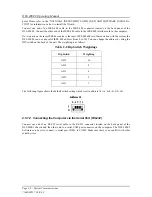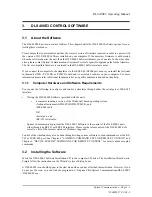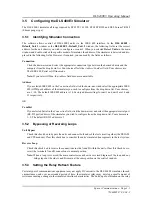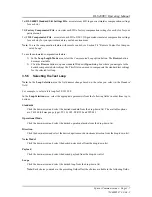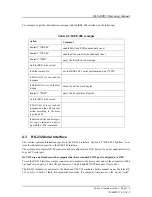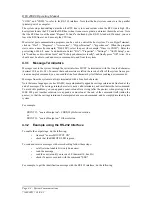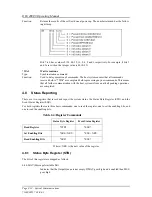
DLS 400E3 Operating Manual
Page 4-4 - Spirent Communications
7104000537 03/04 -2
"COM1" and "COM2" to refer to the RS-232 interface. Note that the host system cannot use the parallel
(printer) port of a computer.
The system stops transmitting data when the RTS line is low, and restarts when the RTS line is high. The
host system lowers the CTS and the DSR lines when it cannot accept data, and raises them when it can. Note
that the RTS line is not the usual "Request To Send" as defined by the RS-232 standard. If desired, you can
leave the RTS line set, and use only the CTS line.
Most serial port communication programs can be used to control the host system. To use HyperTerminal,
click on "Start" > "Programs" > "Accessories" > "HyperTerminal" > "hypertrm.exe". When the program
starts, enter a name (for example; "DLS 400"); select the port, (for example; "Direct to COM1"). Enter the
port settings: 9600, 8, none, 1 and hardware. Select "File" > "Properties" > "Settings" > "ASCII Setup", ena-
ble "Send line ends with line feeds" and "Echo typed characters locally", and finally press "OK" twice. You
should now be able to send and receive commands to and from the system.
4.3.1
Message Terminators
Messages sent to the system through the serial interface MUST be terminated with the line feed character
(decimal 10, hex 0A, LF). To ensure that no characters are left in the receive buffer of the system from a pre-
vious incomplete command, you can send the line feed character by itself before sending new commands.
Messages from the system are always terminated with a Line Feed character.
Note that some languages, such as BASIC, may automatically append a carriage return and a line feed at the
end of messages. The carriage return character is not a valid terminator, and invalidates the last command.
To avoid this problem, you can append a semi-colon after a string (after the quotes) when printing to the
IEEE 488 port. Another solution is to append a semi-colon at the end of the command itself (inside the
quotes), so that the carriage return can be interpreted as a second command, and be simply discarded by the
system.
For example:
PRINT #1, ":sourceB:output on"+CHR$(10);Preferred solution
or
PRINT #1, ":sourceB:output on;" Other solution
4.3.2
Example using the RS-232 Interface
To enable the output stage, do the following:
•
transmit ":sourceB:OUTPUT ON"
•
check that the REMOTE LED is green
•
To send and receive messages with error checking follow these steps:
•
set all relevant enable bits (only done once)
•
send the message
•
read the answer until you receive LF (decimal 10, hex 0A)
•
check if an error occurred with the command *ESR?
For example, to get the identification message with the RS-232 interface, do the following:
Summary of Contents for DLS 400E3
Page 1: ...Operating Manual DLS 400E3 ADSL European Wireline Simulator Revision 2 March 2004...
Page 2: ......
Page 10: ...DLS 400E3 Operating Manual Page 1 6 Spirent Communications 7104000537 03 04 2...
Page 52: ...DLS 400E3 Operating Manual Page 7 2 Spirent Communications 7104000537 03 04 2...
Page 56: ...DLS 400E3 Operating Manual Page 9 2 Spirent Communications 7104000537 03 04 2...
Page 58: ...DLS 400E3 Operating Manual Page 10 2 Spirent Communications 7104000537 03 04 2...
Page 64: ...DLS 400E3 Operating Manual Page 12 4 Spirent Communications 7104000537 03 04 2...

